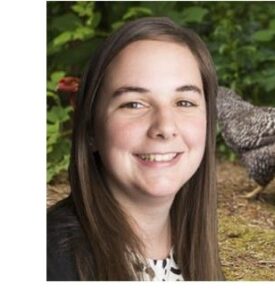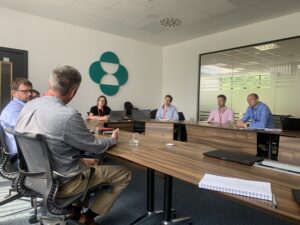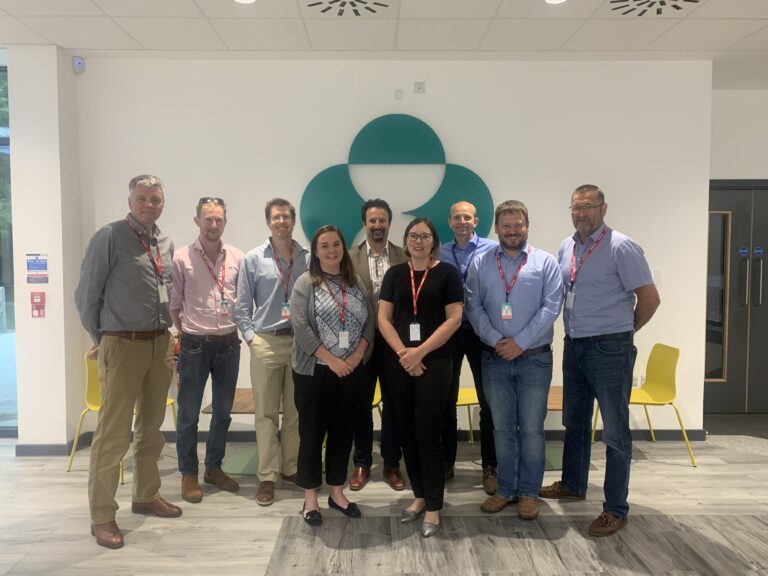In June, Poultry Business held a round table discussion, sponsored by MSD Animal Health. PB editor
Chloe Ryan was joined by a panel of experts to discuss two topics: the best approaches to managing
coccidiosis, and getting the most out of on-farm data.








Coccidiosis in poultry exacerbates a number of other diseases and can predispose poultry to infection with food-borne pathogens. It also often disrupts the intestinal microbiome resulting in poor production performance, health and welfare problems. So, what are the current approaches to control? And what can the UK learn from how it is managed in other markets, such as Spain, Italy and France?
The most common approach in the UK is to use a combination of ionophores delivered in the feed, alongside anticoccidial chemicals. This combined with a chemical disinfectant at turnaround is often used to keep on top of the problem.
Broiler farmer Robert Lanning said Devonshire Poultry took this approach, but also used probiotics to boost birds’ gut health. Jon Sargent, of Hay Farms, said his business took a similar approach, but regularly cycled between different products to avoid resistance developing. “We rotate the ionophore every six months and we add a chemical in every two years.”
Sargent said, in addition, he very occasionally used a water treatment if there were clinical cases on farms. He described the tight focus he and his team had on coccidiosis. “It is a constant issue in our business whether we
are on the right coccidiostats and we make a coccidiostat plan for multiple years ahead. We review our performance at our board meeting every six weeks and we discuss resistance to coccidiostats and our programme every time we sit down.”
Tom Kendal, of Forest Poultry, said he made sure to rotate products between winter and summer. Every two years he used a chemical product, plus disinfectant. In addition, Kendal said he used an oregano supplement to boost gut health in the birds to help fight off the coccidiosis challenge.
It was clear from the discussion that taking a proactive approach and considering the possibility of resistance building up was an important factor for all the producers.
RESISTANCE
Wesley Thorne, of MSD, said despite the careful approach of many producers, resistance was building within the industry to some commonly used products. “Over the decades we have continually used this combination of ionophores and some chemicals and it has been well recorded and proven that resistance exists.”

He cited a study from in 1980s that looked at the sensitivity of the field strains compared to ionophore compounds. MSD carried out a new study in late 2020, taking 27 samples from broiler markets in 10 different countries. The samples were tested for sensitivity to see the level of resistance.
“We found the difference between the late 80s and now showed that there is more resistance,” said Thorne. This is important, he added, because the presence of sub-clinical coccidiosis depresses the potential of the broiler genetics.
Thorne then raised the topic of how vaccines could be used as part of a strategy to ‘re-sensitise’ those ionophores. “We believe using vaccines as a tool to re-sensitise these anticoccidials to extend the lifespan and sustainability is a really useful technique,” he said. Thorne said vaccines were being employed in other markets, in particular Spain and Italy, and in France.
Out of all the different types of anticoccidials, it is chemicals that are most likely to build resistance very quicky, said Thorne. “If you were building a strategy to control coccidiosis, my view is you would use vaccines during the summer months when generally the cocci challenge would be the lowest.”
He said this strategy was working very well for businesses on the Continent. “Certain integrators in Spain, after several years of using this rotation, are seeing the benefits in feed conversion ratio. Looking at the performance of their farms on an annualised basis they are seeing that after using vaccines as a rotation, the subsequent flocks going back on to ionophores are performing a lot better than they would have done if they were persistently on ionophores.”
THE VETS’ VIEW
Daniel Parker, of Slate Hall Veterinary Services, said the rationale for re-sensitising was “a sensible approach and it’s got real merit, if you have evidence of resistance”. However, he noted there was a reluctance to move away from tried and tested systems already widely used in the UK. “The history of using vaccine in this country has not been very successful,” said Parker. “And that is probably in part related to the stocking density we use and the age of broiler that we grow to. In European markets, where you have longer lived birds and lower stocking densities, vaccines tends to work better.”
He noted, though, that the UK had a distinct advantage were it to vaccinate, compared to countries like the USA, because the UK market has access to vaccines that make use of attenuated strains of coccidiosis. “If you go to the States, they have cocci vaccines which are completely unattenuated so they’re basically field strains and it’s like field exposure,” he said.
“Over here we have attenuated strains, so by using a vaccine, you will replace the wild strain, because it replicates very effectively and crowds out the natural background coccidiosis.” This then seeds the environment with a precocious strain that replaces the wild strain.
Sean Wisdom, of St David’s Poultry Team, added that the precocious strains respond better to the anti-coccidials used on the next flock.
THE FUTURE FOR IONOPHORES
The panel discussed scenarios whereby the status quo was disrupted suddenly and the industry was forced to make a change. They talked about Norway, where the poultry industry suddenly stopped using ionophores in 2015 following scaremongering by a politician. The industry, facing rapidly falling sales, made the decision to stop using ionophores and instead switched to vaccines.
Several years ago, there was a wider threat over the continued use of ionophores throughout Europe, after the Federation of Veterinarians in Europe pushed to have ionophores classified as veterinary medicines, rather than feed additives, as they currently are.
Parker explained this would have been hugely damaging, because it would have meant every single load of feed would have had to be subject to a prescription. In addition, he said “you cannot prescribe veterinary medicines prophylactically. And, if you don’t use ionophores prophylactically you can’t use them. So, basically we would lose them.”
He said the background to this was a shift in the American poultry market. “The issue arose with the no antibiotic-ever-movement in the States, which is where the whole topic of ionophores is being tarnished, because it’s not
a simple concept to understand,” said Parker.
“These particular products, while they are antibiotics, they are not antibiotics that ever get used for humans, so they are specific to poultry only.”
RAPID CHANGE
This threat has passed for now, due to significant lobbying to keep coccidiostats within the feed additives legislation. However, these two points highlighted how the industry’s current approach is not guaranteed in the years ahead.
Thorne said if a rapid change did come about, the UK industry was not prepared. “If the market moves quickly, we cannot respond quickly and nor can any other pharmaceutical company.” A the time of the change in Norway, MSD was the only supplier of Paracox 5, a coccidiosis vaccine. Despite the Norwegian market being small – just 70 million broilers – “we struggled to meet that demand,” said Thorne. “We had to allocate stock to prioritise Norway because that’s all they had as a tool and other markets throughout the world were rationed back.
“There are now other suppliers who supply products like Paracox 5 so I don’t know what the manufacturing capacity is like of others, but it is unlikely to be able to be switched on and ramped up very significantly very, very quickly. That worries me.
“We have got a Paracox 5 building here that packs and blends all of the product, and that building took us five years to build, and that was a fast job.”
SCEPTICISM
The producers on the panel expressed some scepticism about how adaptable UK poultry business would be to alternative approaches. Sargent said it would be very hard to convince a poultry business to try a completely new approach, due to the risks involved if it didn’t work.
“It takes the entire holistic health of that bird and – gamble is the wrong word – but by God, I can imagine walking in and saying to Jonty, the business owner, ‘right, I’m getting rid of the coccidiostats and we’re doing four cycles of vaccines’. He would fall off his chair. We can talk about Spain and Italy and France but the UK industry trusts the UK industry. We are very inward looking. If Robert was using vaccine on his farm, I’d be very happy to talk to him and go and see what he was doing, and I would get to know it and then I might speak to our vets. That’s how the UK industry works.
“You’ve got to get somebody that’s going to have a go at it. And that’s scary.”
Thorne suggested maybe a central organisation like the British Poultry Council (BPC) could lead a project to try a different approach. “There is the real potential to make improvements in broiler performance,” he said.
“It’s tricky because if we feel there’s a high risk to it, it’s hard to accept we should trial it,” Sargent responded.
A GAMBLE TOO FAR?
Kendal echoed Sargent’s point. “It is very scary because it’s a gamble,” he said. “At the moment is the gamble worth the benefits? No, but if the work is done with people knowing how it works, then the benefits may outweigh the risks, but that is a long process and you’ve got to gain people’s trust because somebody’s got to take the first step.”
Lanning said any change in approach would have to first be run past the producers’ customer – the processor. “First of all ,you got to sell it to the integrator,” he said. “It is such a big risk if I get one or two farms performing badly.
So, you want some sort of underwriting. So, you first of all need to sell it to the integrator then underwrite it in order to sell it to me.”
Wisdom added: “The veterinary argument for vaccination is very interesting and it makes sense and I would like to be involved in it, but I’ve heard the words risk and gamble coming from the producers.
“An arrangement whereby you can mitigate against the risk would seem like the way forward.
SECOND SESSION: DATA MANAGEMENT
During the second session, the panel looked at data on farm, how it can be best used to improve productivity, and animal health and welfare outcomes.
There are many types of data routinely collected on farm including sensory data from within the poultry house, plus mortality, performance information, and biosecurity records. Farms all take a different approach, some highly automated and digital, others largely manual and written down with pen and paper.
Lanning said three of his poultry farms used SenseHub Poultry, a service that collects and analyses data. He explained the service completely captured all data on CO2, humidity, lux, weight, and water, with readings taken every 15 minutes. “On top of that we still do min and max carbon dioxide levels, and mortality, which we record on Excel spreadsheets.”
He added Sensehub Poultry provided full breakdowns of the data recorded, with graphs. “Then it comes back to me and I look at it and try to get a grip of it. We have got so much data, but sometimes we don’t use it enough because it’s too big.”
Sargent said at Hay Farms, two systems were in place: one automatic and one manual. “On probably 50% of our sheds, we have the ability to collect sensor data per minute. We then have an Excel sheet where we collect data, including mortality.” He said each day an email was sent to all the area managers, showing a summary of data on the farms for the past seven days.
Kendal said, at Forest Poultry, the approach was very much manual. “It is initially done on pen and paper and then transferred to Excel,” he said. “We collect all the usual – mortality, temperature, humidity.” He added the company could do more to analyse the data that at the end of each crop, and make changes based on the findings. “We look at it but not as in depth as we need to, and probably not as scientifically as we should,” he said.
ON THE CUSP
Nick Munce, of SenseHub Poultry, said the industry’s ability to collect frequent and accurate data meant he believed it was on the cusp of a big change in making more use of what was collected. “We have a range of wireless sensors that we can deploy at farm level that are giving a granularity of information, around the key environmental parameters as well as water and weight,” he said. “And then additionally we’ve got the tools to really understand that information in terms of the data analytics capability that really lets you understand what the key correlations are and how you can make changes to improve.”
Munce added that the increasing sophistication of machine learning would help move the industry on. “It will take time to get there because you need a core level of this technology employed across a number of houses to develop the algorithms that are going to be of great value to the industry, but we’re making really good progress with that.”
He gave an example of how algorithms were already being deployed to improve performance on farm. “I just recently launched a weight prediction algorithm using the real time weigh platforms. You can put in your target at the start of the crop, and then from 11 days onward it will predict your endpoint with a percentage probability, and it gets more accurate as the days pass. There are potentially huge benefits to the industry. Certainly, down the line it is all going to be about predictive algorithms helping to hit key performance indicators.”
Lanning described the set-up he had on his farms. “We have 30 temperature sensors per house, and you would be amazed at the different zones you see within the house,” he said. “You think humidity would be far more even than it is. There is a huge swing in humidity. And then you can drill down into why the temperature is cooler in one corner. It’s nothing that a good stockman doesn’t sense walking around, but makes it easy for all to see.” Technology would never replace a stockman, he said, but it does provide a further tool.
BIG VARIATION
Aimee Mahony said she visited a lot of poultry farms in her role as chief poultry advisor with the NFU and there was a great deal of variation in how much data was collected and how well it was used. “Everyone will be collecting what we might call the minimum for Red Tractor to audit or to meet legislation, and then others are doing additional things.
“On some farms, they take you into the office and they have 50 screens, and they tell you, ‘I can see what the birds are doing here, I know what they were doing at this time, I know what the temperature is’ and they’re so proud. They know everything that’s going on from a technology perspective. I will go to another farm where they probably don’t have a computer screen at all, but they want to take you in the shed and show you the birds and they will equally know, ‘yes, we’ve had a dip in temperature’ and they will know it because they’re physically in there.”
The ability to collect and analyse data has benefits across the whole supply chain. Parker described a project he had recently worked on as part of the BPC’s lobbying efforts against new rules that would limit the range of temperatures within which poultry could be transported.
He said technology had allowed him to work alongside colleagues at the Royal Veterinary College to look at data from 24,000 journeys, and build a really thorough picture of how poultry respond to being transported in different temperatures.
NEW TRIALS
Lanning said he had recently carried out some trials on humidity levels and their relationship to coccidiosis levels, which he wouldn’t have been able to do had it not been for all the data being collected on his farm. He said the data suggested humidity was too low early on in each cycle, and so he started running higher humidity for the first week, which in theory should have brought on the cocci challenge earlier which would then have helped with the weights at end.
Unfortunately, the trial was not successful. “By the time we’ve got humidity where we wanted, it was actually too late, we needed to bring it down and it was like trying to turn an oil tanker. The humidity led to sticky litter, which led to pododermatitis.”
Despite the unwanted result, Lanning said the business learnt a lot from the trial, which would not have been possible without the level of data they currently collect. “Yes, it was the wrong thing to do but we learned so much from it. What we learned was to keep those humidities much, much lower.”
The panel discussed some of the potential problems that came with collecting a lot of data. Sargent said there was a possibility some members of staff would find it intrusive if they knew their every move and decision was being monitored. “It is quite unnerving to managers, and there is a fear of micromanagement,” he said. Thorne said some stockmen could use it as an excuse to look at screens rather than the birds, and said he had recently been on a farm where some birds were panting in a shed. He reported the problem to the stockman, who consulted a screen and said everything was fine, without going in to investigate.
MISINTERPRETATION
There is also the problem of potentially misinterpreting data. Wisdom gave the example of case he worked on investigating breeder mortality and trying to link it to the broiler mortality.
“The data for the breeders suggested that it was a problem in all five houses on the breeder farm. However, when we went and looked at the data we found they had taken the total for the day and divided it evenly amongst all the houses.
“When I went to the farm I realised the issue was actually only in house two. But this particular farm manager didn’t like computers so it was easier for him to send it to a clerk at the integrator who simply divided it among the houses. So, there is a human element here.”
Munce said this was why the increasing adoption of systems that automatically collected data was an important step forward. Given the ongoing problems with recruitment, the panel then discussed whether increasing use of data could help make the poultry sector more attractive for prospective workers. Munce believed it did. “Having people more engaged at a more granular level with technology, so they can see the direct relationship with what they’re doing, helps with staff retention.
“Vets, for example, who are frustrated with the amount of information they have, if you can present them with this data, it triggers their natural analytical capabilities. That means they can do their jobs better and the benefits flow up the chain,” he added.
Mahony said that the young people on the NFU’s Poultry Industry Programme (PIP) had been tasked with promoting the industry to new applicants.
“One of the groups did a video with poultry farmers talking about all the skillsets they rely on, so they talked about vets, nutritionists, breed companies, feed companies, pharmaceutical companies, and data companies. So, they don’t have all those skills themselves but they need people who have, to help their business develop.”
Projects like this help people understand different ways they can have a career in poultry. Which enables them to know that “You don’t necessarily have to be stood in wellies in a pile of poo; there are different ways to get involved.”
SUSTAINABILITY
Another potential benefit was improved efficiency and therefore sustainability. “Producing more from less and being really efficient has benefits in terms of greenhouse gas emissions a lot of companies and producers are coming under scrutiny around that or being asked about what next zero policies they have on farm.”
Munce said SenseHub Poultry was careful not to attempt to define sustainability because it was so challenging, but he added that “being able to measure the parameters and get to their target weights more quickly” was clearly an environmental benefit. “De facto you are using less.”


